Abstract
Gating current, Ig, was recorded in Myxicola axons with series resistance compensation and higher time resolution than in previous studies. Ig at ON decays as two exponentials with time constants, tau ON-F and tau ON-S, very similar to squid values. No indication of an additional very fast relaxation was detected, but could be still unresolved. Ig at OFF also displays two exponentials, neither reflecting recovery from charge immobilization. Deactivation of the two I(ON) components may proceed with well-separated exponentials at -100 mV. INa tail currents at OFF also display two exponentials plus a third very slow relaxation of 5-9% of the total tail current. The very slow component is probably deactivation of a very small subpopulation of TTX sensitive channels. A -100 mV, means for INa tail component time constants (four axons) are 76 microseconds (range: 53-89 microseconds) and 344 microseconds (range: 312-387 microseconds), and for IOFF (six axons) 62 microseconds (range: 34-87 microseconds) and 291 microseconds (range: 204-456 microseconds) in reasonable agreement. INa ON activation time constant, tau A, is clearly slower than tau ON-F at all potentials. Except for the interval -30 to -15 mV, tau A is clearly faster than tau ON-S, and has a different dependency on potential. tau ON-S is several fold smaller than tau h. Computations with a closed2----closed1----open activation model indicated Na tail currents are consistent with a closed1----open rate constant greater than the closed2----closed1.
Full text
PDF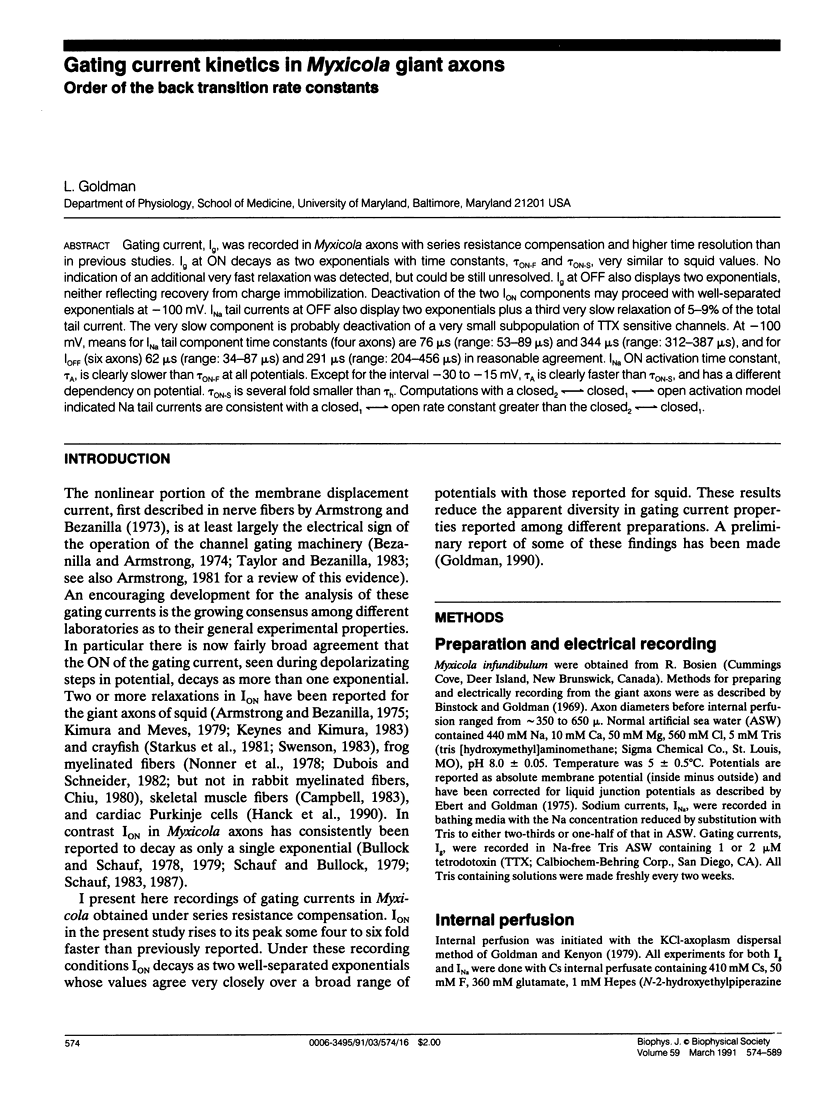
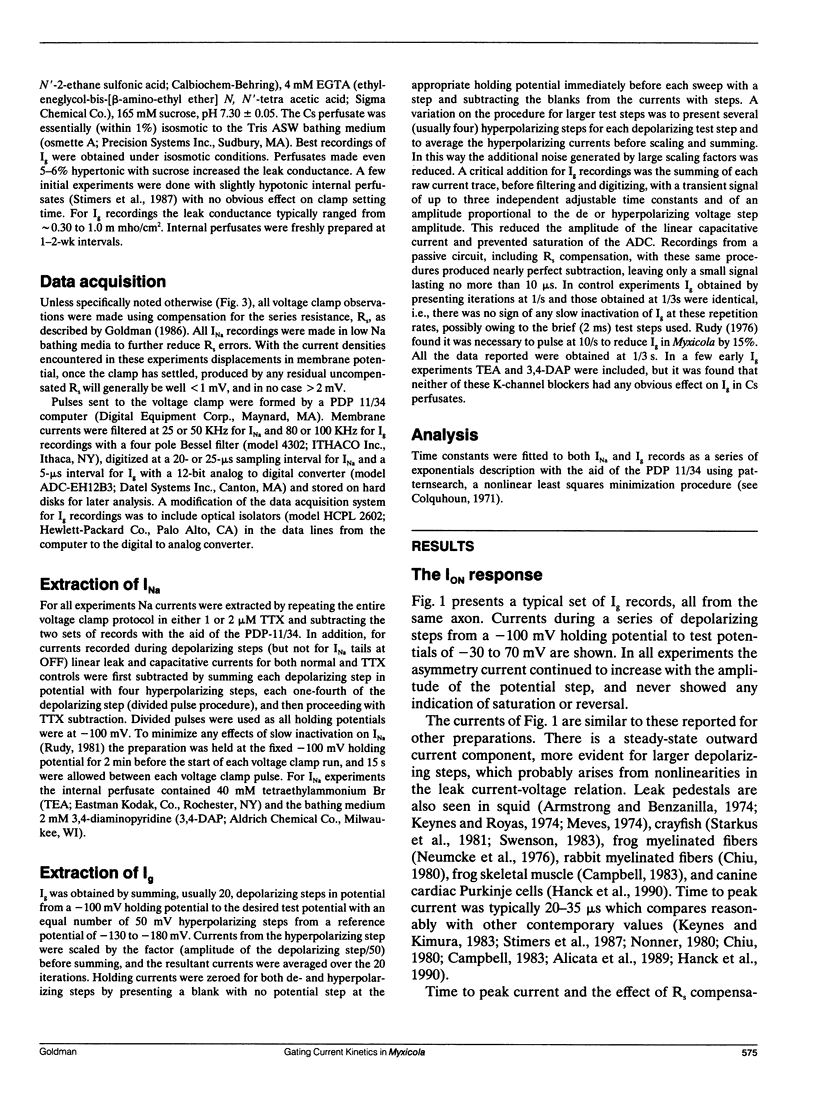
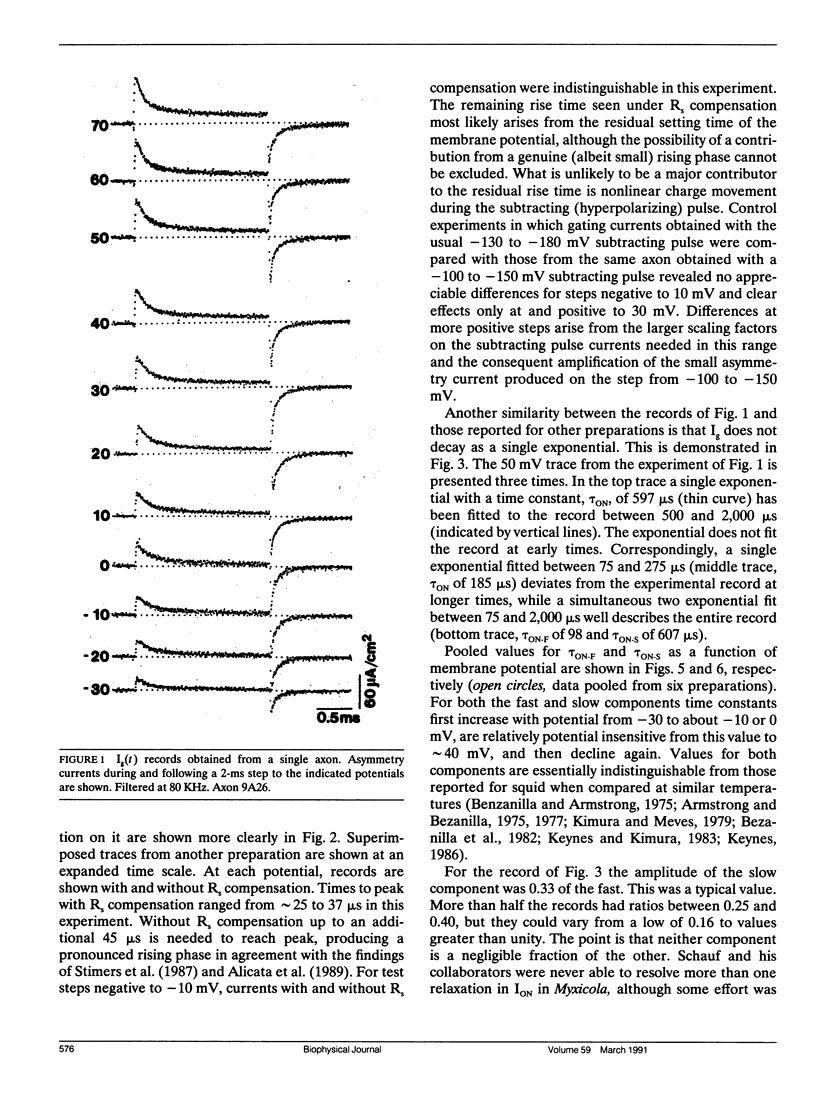
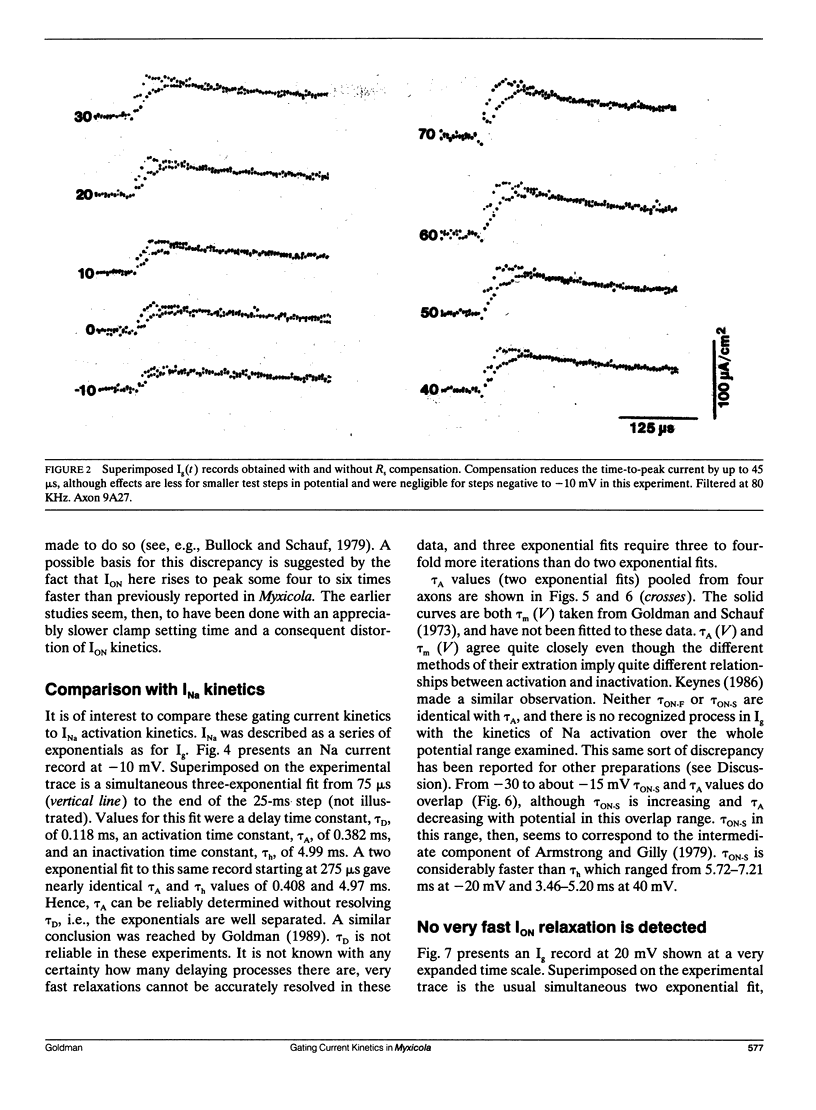
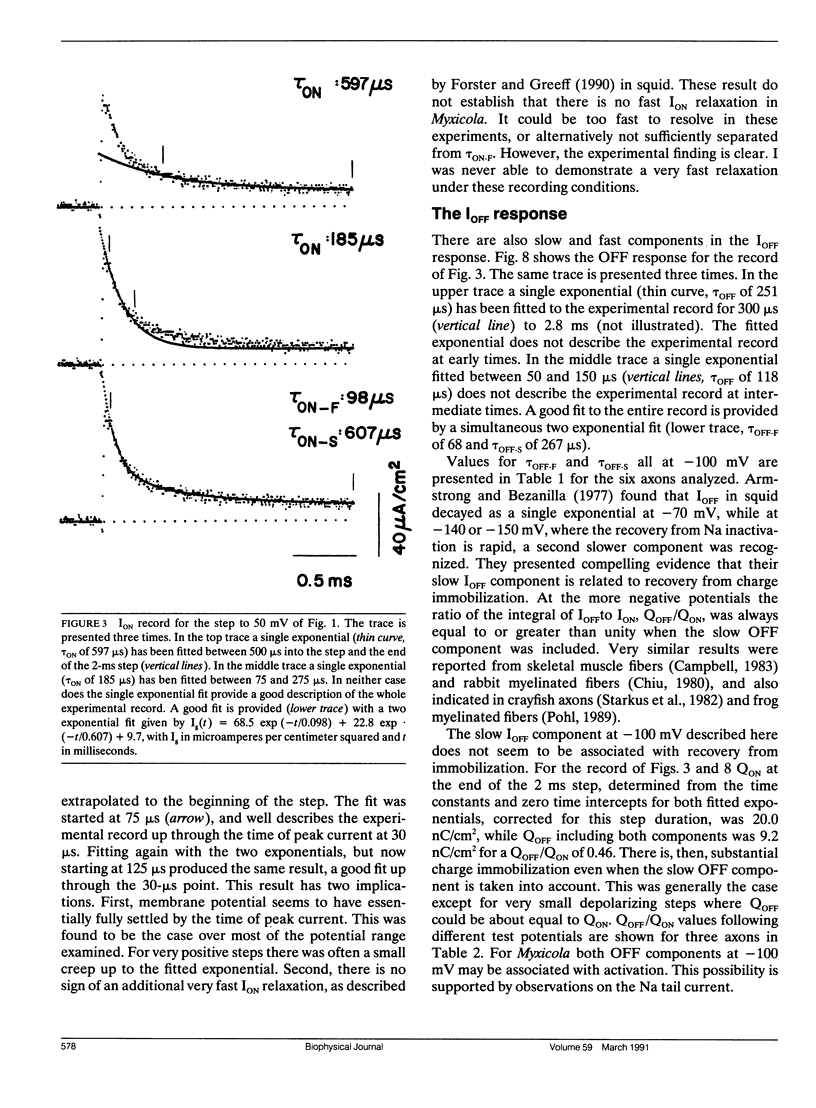
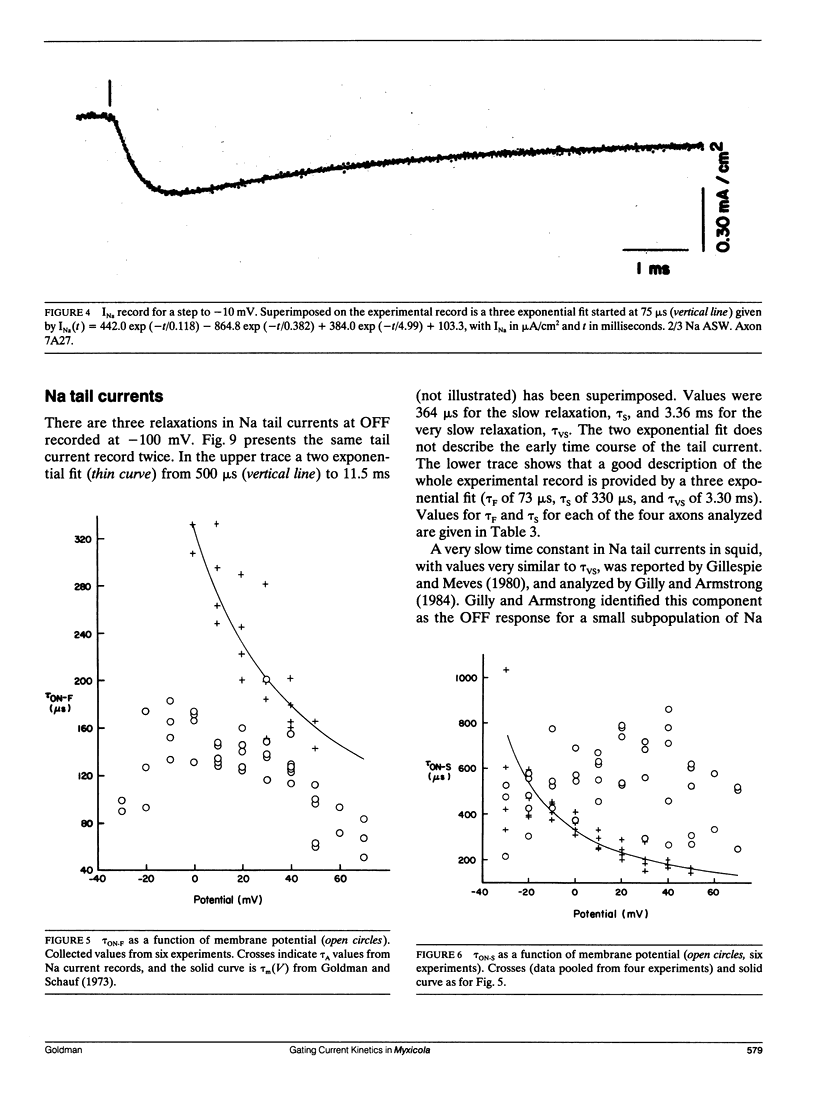
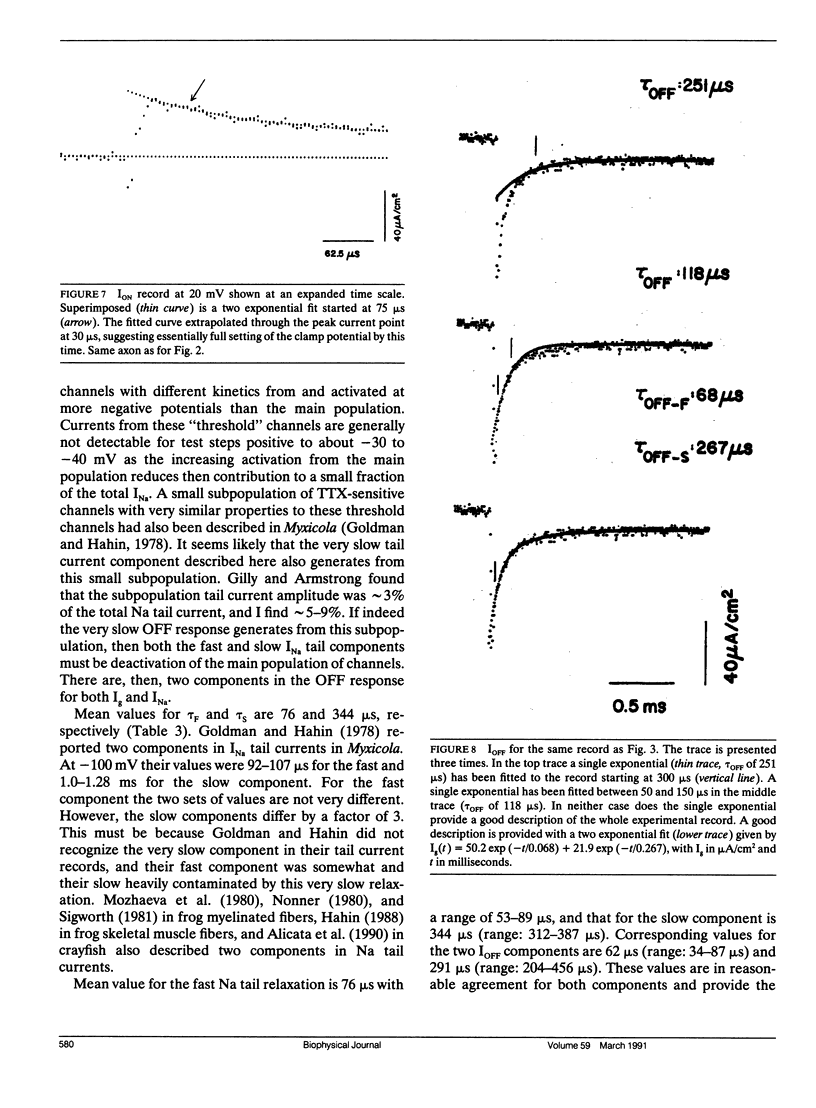
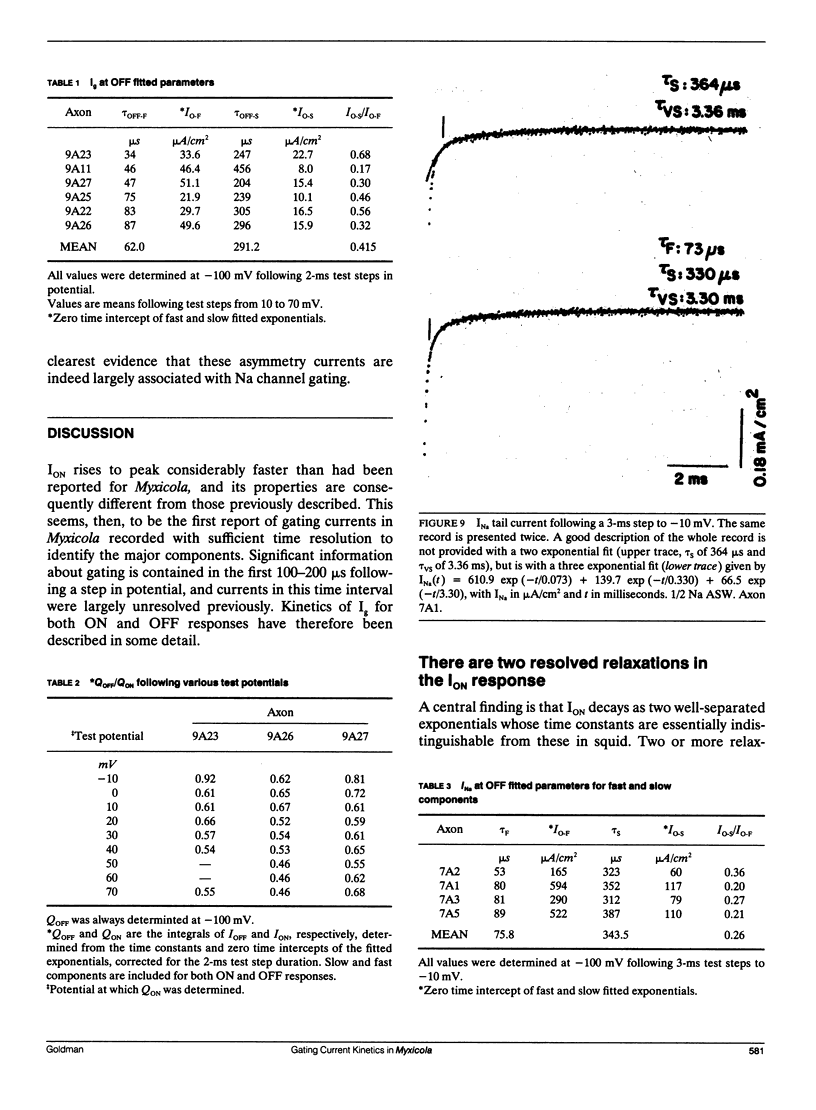
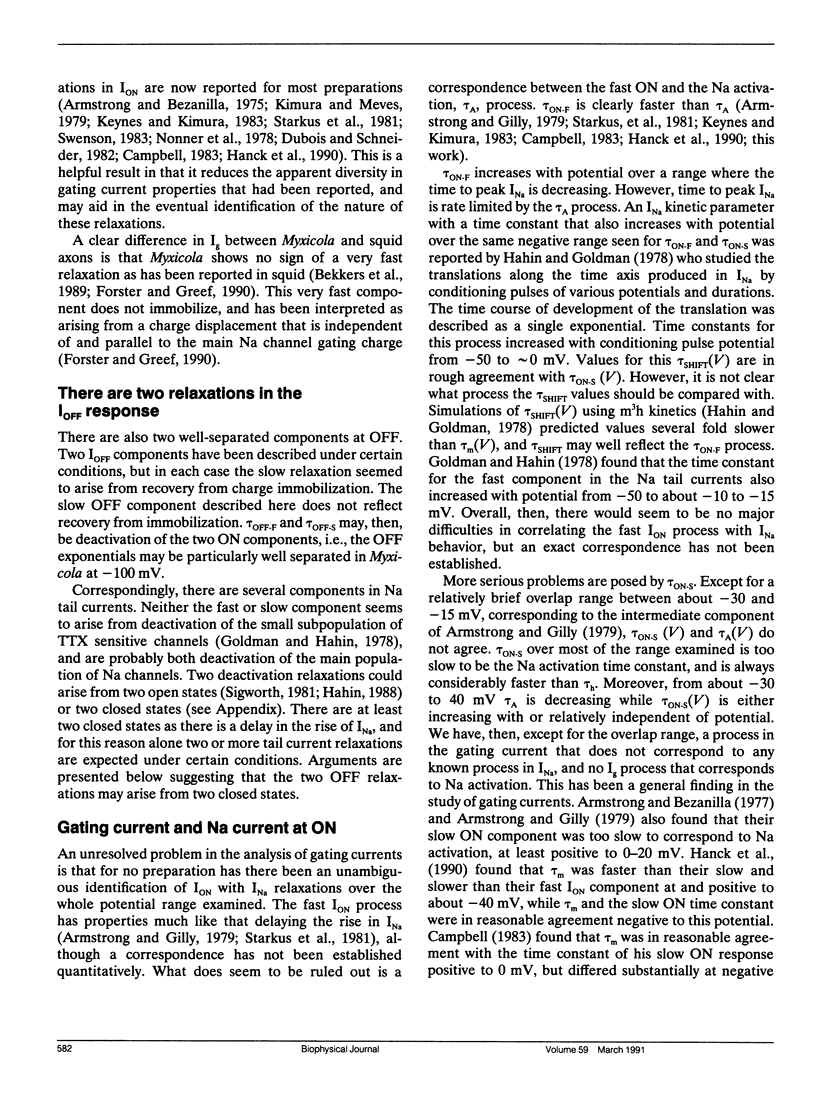
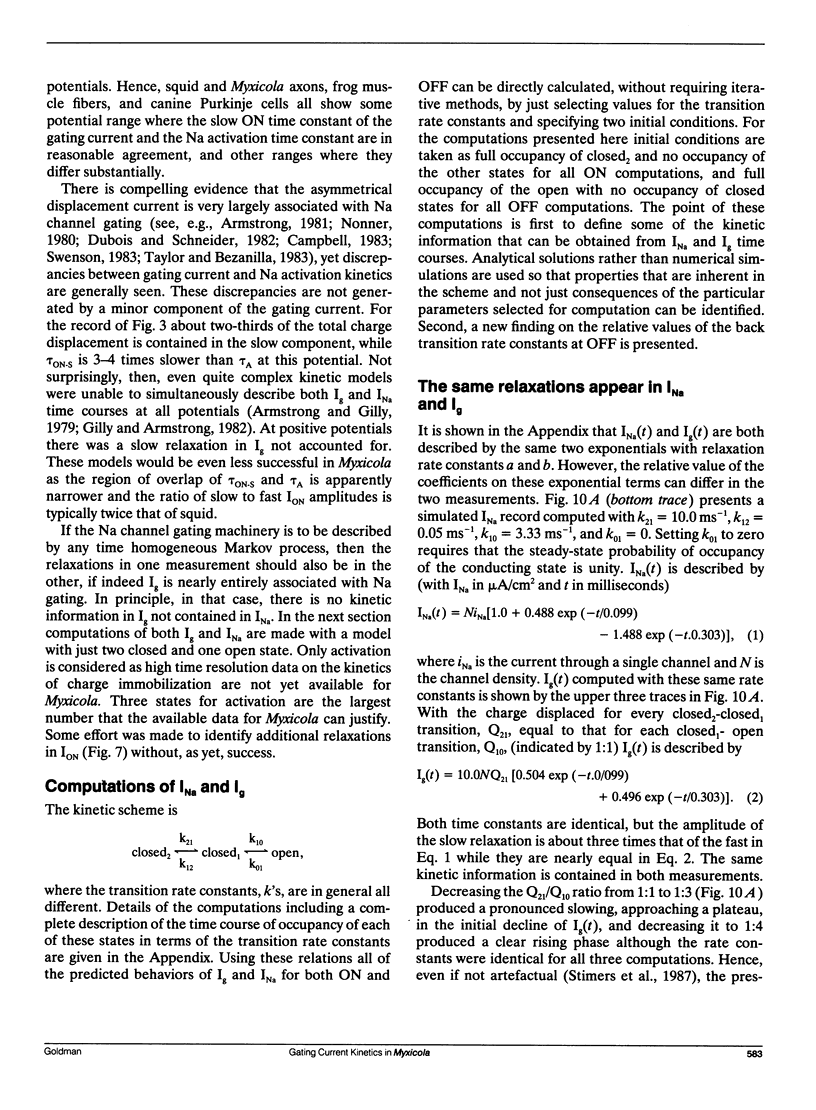
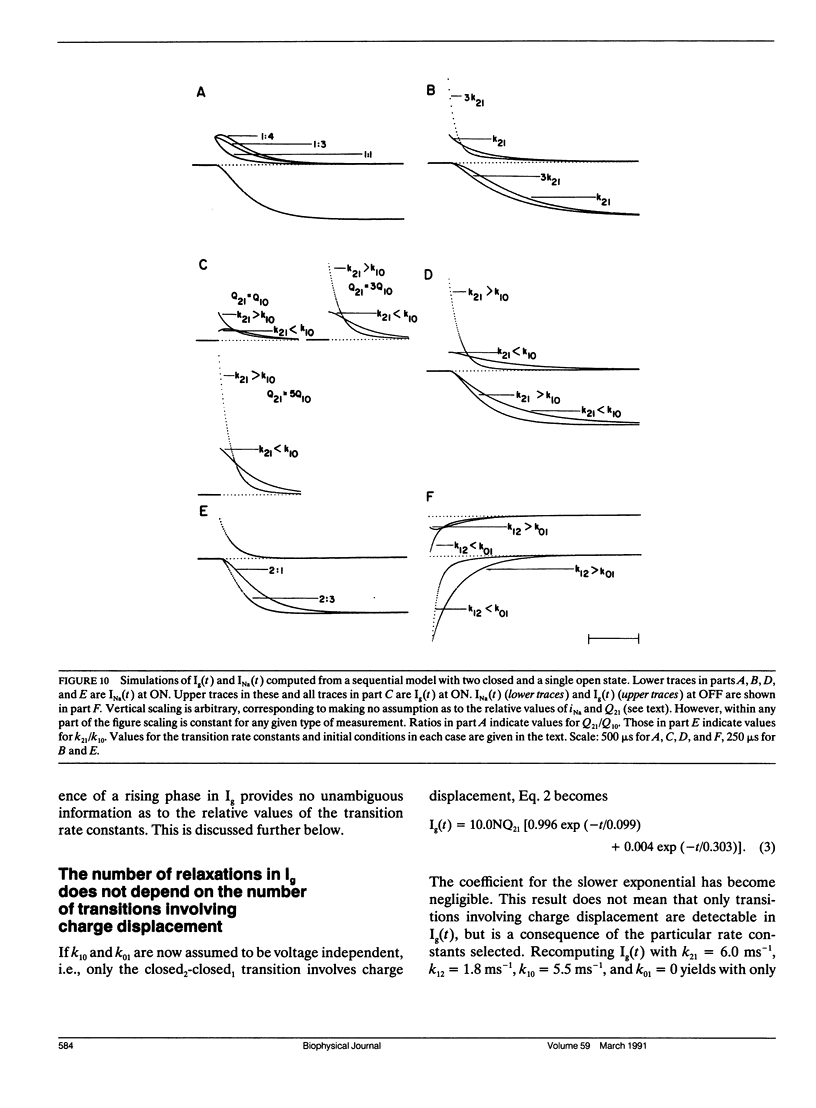
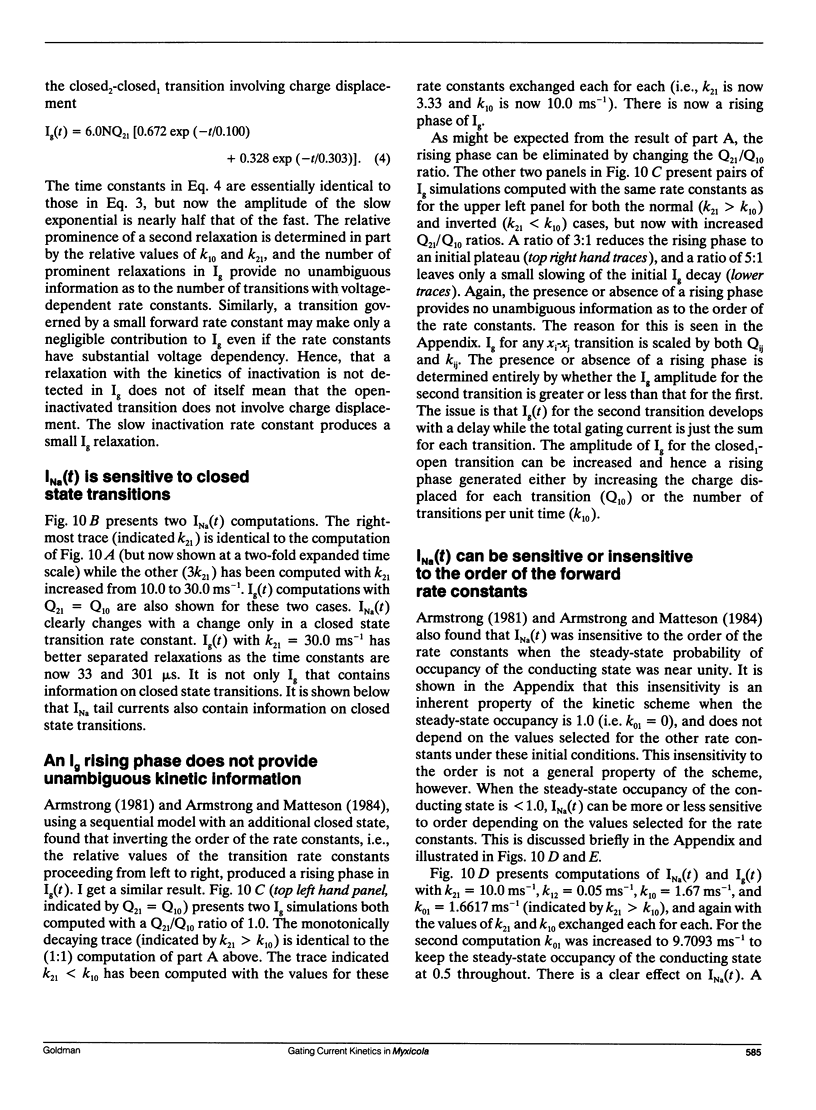
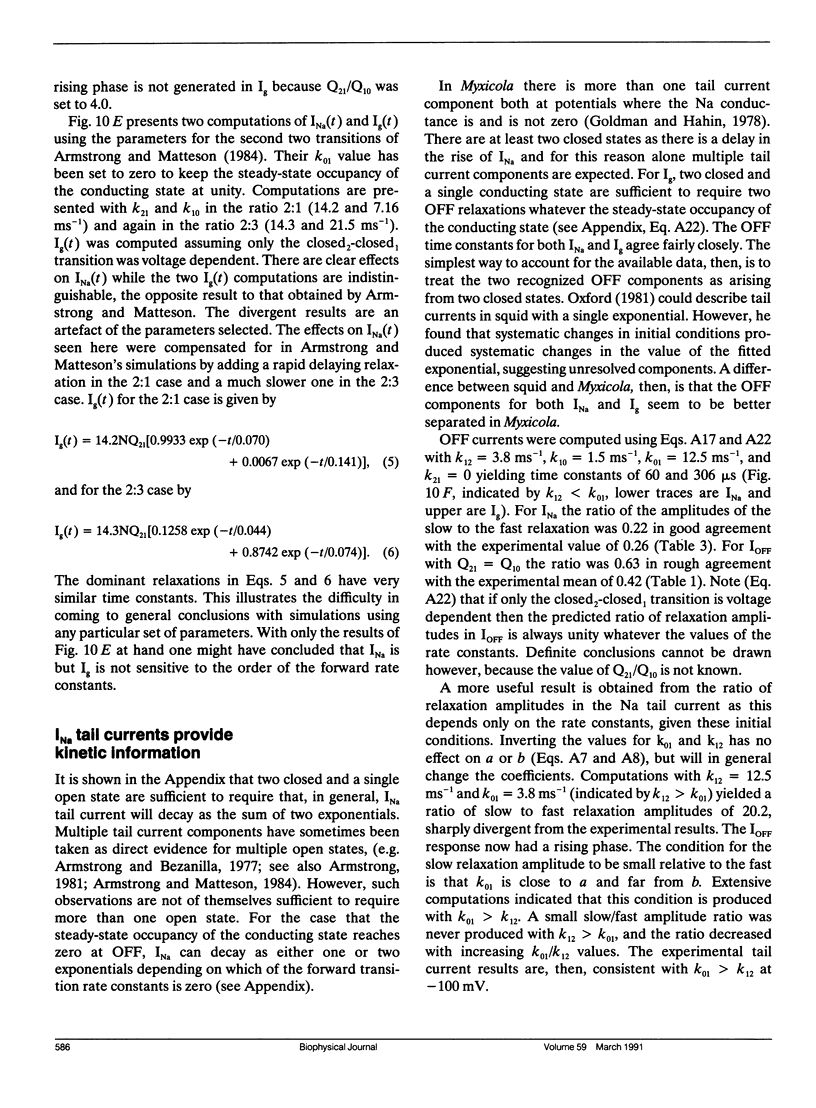
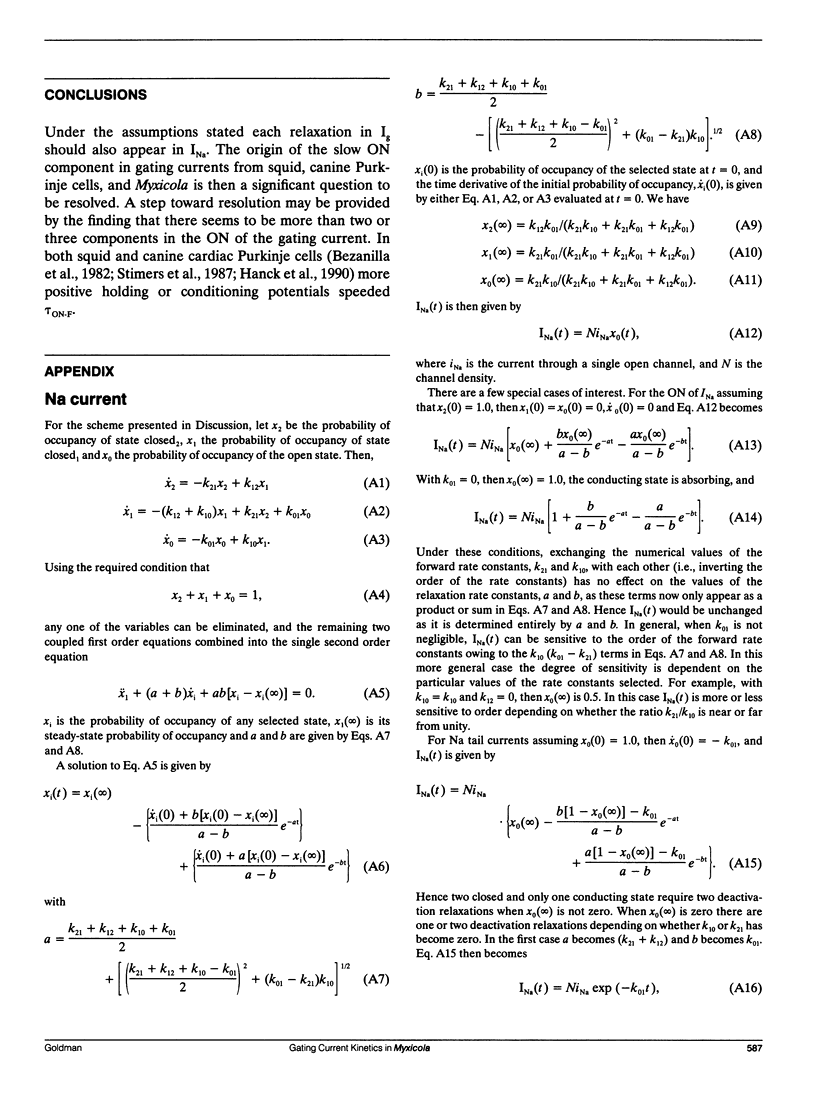
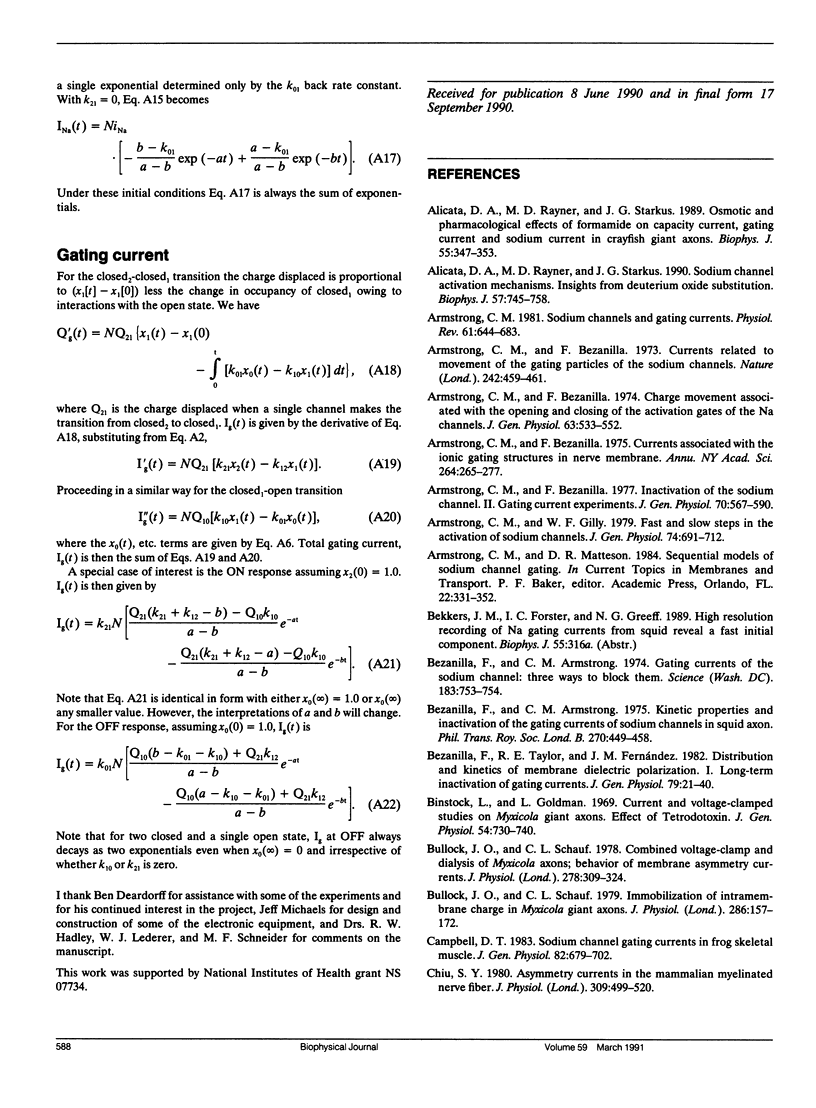
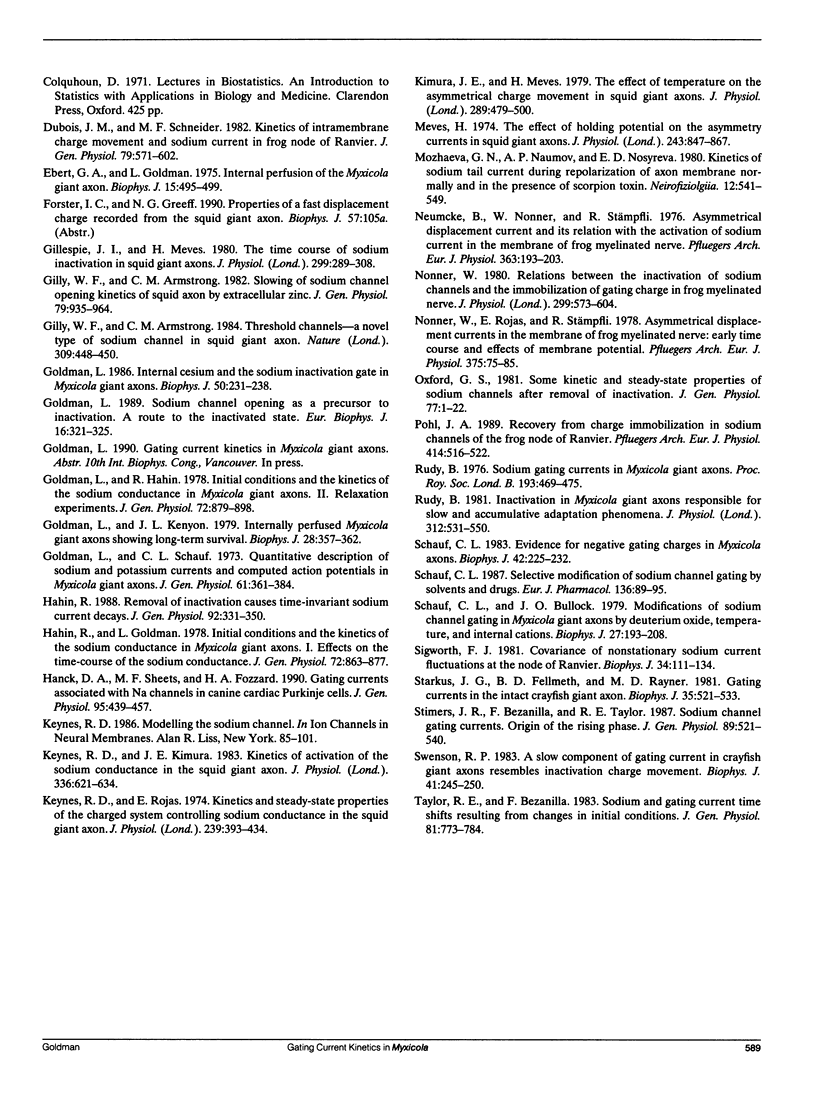
Selected References
These references are in PubMed. This may not be the complete list of references from this article.
- Alicata D. A., Rayner M. D., Starkus J. G. Osmotic and pharmacological effects of formamide on capacity current, gating current, and sodium current in crayfish giant axons. Biophys J. 1989 Feb;55(2):347–353. doi: 10.1016/S0006-3495(89)82811-5. [DOI] [PMC free article] [PubMed] [Google Scholar]
- Alicata D. A., Rayner M. D., Starkus J. G. Sodium channel activation mechanisms. Insights from deuterium oxide substitution. Biophys J. 1990 Apr;57(4):745–758. doi: 10.1016/S0006-3495(90)82595-9. [DOI] [PMC free article] [PubMed] [Google Scholar]
- Armstrong C. M., Bezanilla F. Charge movement associated with the opening and closing of the activation gates of the Na channels. J Gen Physiol. 1974 May;63(5):533–552. doi: 10.1085/jgp.63.5.533. [DOI] [PMC free article] [PubMed] [Google Scholar]
- Armstrong C. M., Bezanilla F. Currents related to movement of the gating particles of the sodium channels. Nature. 1973 Apr 13;242(5398):459–461. doi: 10.1038/242459a0. [DOI] [PubMed] [Google Scholar]
- Armstrong C. M., Bezanilla F. Inactivation of the sodium channel. II. Gating current experiments. J Gen Physiol. 1977 Nov;70(5):567–590. doi: 10.1085/jgp.70.5.567. [DOI] [PMC free article] [PubMed] [Google Scholar]
- Armstrong C. M. Currents associated with the ionic gating structures in nerve membrane. Ann N Y Acad Sci. 1975 Dec 30;264:265–277. doi: 10.1111/j.1749-6632.1975.tb31488.x. [DOI] [PubMed] [Google Scholar]
- Armstrong C. M., Gilly W. F. Fast and slow steps in the activation of sodium channels. J Gen Physiol. 1979 Dec;74(6):691–711. doi: 10.1085/jgp.74.6.691. [DOI] [PMC free article] [PubMed] [Google Scholar]
- Armstrong C. M. Sodium channels and gating currents. Physiol Rev. 1981 Jul;61(3):644–683. doi: 10.1152/physrev.1981.61.3.644. [DOI] [PubMed] [Google Scholar]
- Bezanilla F., Armstrong C. M. Gating currents of the sodium channels: three ways to block them. Science. 1974 Feb 22;183(4126):753–754. doi: 10.1126/science.183.4126.753. [DOI] [PubMed] [Google Scholar]
- Bezanilla F., Armstrong C. M. Kinetic properties and inactivation of the gating currents of sodium channels in squid axon. Philos Trans R Soc Lond B Biol Sci. 1975 Jun 10;270(908):449–458. doi: 10.1098/rstb.1975.0022. [DOI] [PubMed] [Google Scholar]
- Bezanilla F., Taylor R. E., Fernández J. M. Distribution and kinetics of membrane dielectric polarization. 1. Long-term inactivation of gating currents. J Gen Physiol. 1982 Jan;79(1):21–40. doi: 10.1085/jgp.79.1.21. [DOI] [PMC free article] [PubMed] [Google Scholar]
- Binstock L., Goldman L. Current- and voltage-clamped studies on Myxicola giant axons. Effect of tetrodotoxin. J Gen Physiol. 1969 Dec;54(6):730–740. doi: 10.1085/jgp.54.6.730. [DOI] [PMC free article] [PubMed] [Google Scholar]
- Bullock J. O., Schauf C. L. Combined voltage-clamp and dialysis of Myxicola axons: behaviour of membrane asymmetry currents. J Physiol. 1978 May;278:309–324. doi: 10.1113/jphysiol.1978.sp012306. [DOI] [PMC free article] [PubMed] [Google Scholar]
- Bullock J. O., Schauf C. L. Immobilization of intramembrane charge in Myxicola giant axons. J Physiol. 1979 Jan;286:157–171. doi: 10.1113/jphysiol.1979.sp012611. [DOI] [PMC free article] [PubMed] [Google Scholar]
- Campbell D. T. Sodium channel gating currents in frog skeletal muscle. J Gen Physiol. 1983 Nov;82(5):679–701. doi: 10.1085/jgp.82.5.679. [DOI] [PMC free article] [PubMed] [Google Scholar]
- Chiu S. Y. Asymmetry currents in the mammalian myelinated nerve. J Physiol. 1980 Dec;309:499–519. doi: 10.1113/jphysiol.1980.sp013523. [DOI] [PMC free article] [PubMed] [Google Scholar]
- Dubois J. M., Schneider M. F. Kinetics of intramembrane charge movement and sodium current in frog node of Ranvier. J Gen Physiol. 1982 Apr;79(4):571–602. doi: 10.1085/jgp.79.4.571. [DOI] [PMC free article] [PubMed] [Google Scholar]
- Ebert G. A., Goldman L. Internal perfusion of the myxicola giant axon. Biophys J. 2009 Jan 1;15(5):495–499. doi: 10.1016/S0006-3495(75)85833-4. [DOI] [PMC free article] [PubMed] [Google Scholar]
- Gillespie J. I., Meves H. The time course of sodium inactivation in squid giant axons. J Physiol. 1980 Feb;299:289–307. doi: 10.1113/jphysiol.1980.sp013125. [DOI] [PMC free article] [PubMed] [Google Scholar]
- Gilly W. F., Armstrong C. M. Slowing of sodium channel opening kinetics in squid axon by extracellular zinc. J Gen Physiol. 1982 Jun;79(6):935–964. doi: 10.1085/jgp.79.6.935. [DOI] [PMC free article] [PubMed] [Google Scholar]
- Gilly W. F., Armstrong C. M. Threshold channels--a novel type of sodium channel in squid giant axon. 1984 May 31-Jun 6Nature. 309(5967):448–450. doi: 10.1038/309448a0. [DOI] [PubMed] [Google Scholar]
- Goldman L., Hahin R. Initial conditions and the kinetics of the sodium conductance in Myxicola giant axons. II. Relaxation experiments. J Gen Physiol. 1978 Dec;72(6):879–898. doi: 10.1085/jgp.72.6.879. [DOI] [PMC free article] [PubMed] [Google Scholar]
- Goldman L. Internal cesium and the sodium inactivation gate in Myxicola giant axons. Biophys J. 1986 Aug;50(2):231–238. doi: 10.1016/S0006-3495(86)83457-9. [DOI] [PMC free article] [PubMed] [Google Scholar]
- Goldman L., Kenyon J. L. Internally perfused Myxicola giant axons showing long-term survival. Biophys J. 1979 Nov;28(2):357–361. doi: 10.1016/S0006-3495(79)85182-6. [DOI] [PMC free article] [PubMed] [Google Scholar]
- Goldman L., Schauf C. L. Quantitative description of sodium and potassium currents and computed action potentials in Myxicola giant axons. J Gen Physiol. 1973 Mar;61(3):361–384. doi: 10.1085/jgp.61.3.361. [DOI] [PMC free article] [PubMed] [Google Scholar]
- Goldman L. Sodium channel opening as a precursor to inactivation. A route to the inactivated state. Eur Biophys J. 1989;16(6):321–325. doi: 10.1007/BF00257880. [DOI] [PubMed] [Google Scholar]
- Hahin R., Goldman L. Initial conditions and the kinetics of the sodium conductance in Myxicola giant axons. I. effects on the time-course of the sodium conductance. J Gen Physiol. 1978 Dec;72(6):863–877. doi: 10.1085/jgp.72.6.863. [DOI] [PMC free article] [PubMed] [Google Scholar]
- Hahin R. Removal of inactivation causes time-invariant sodium current decays. J Gen Physiol. 1988 Sep;92(3):331–350. doi: 10.1085/jgp.92.3.331. [DOI] [PMC free article] [PubMed] [Google Scholar]
- Hanck D. A., Sheets M. F., Fozzard H. A. Gating currents associated with Na channels in canine cardiac Purkinje cells. J Gen Physiol. 1990 Mar;95(3):439–457. doi: 10.1085/jgp.95.3.439. [DOI] [PMC free article] [PubMed] [Google Scholar]
- Keynes R. D., Kimura J. E. Kinetics of activation of the sodium conductance in the squid giant axon. J Physiol. 1983 Mar;336:621–634. doi: 10.1113/jphysiol.1983.sp014601. [DOI] [PMC free article] [PubMed] [Google Scholar]
- Keynes R. D., Rojas E. Kinetics and steady-state properties of the charged system controlling sodium conductance in the squid giant axon. J Physiol. 1974 Jun;239(2):393–434. doi: 10.1113/jphysiol.1974.sp010575. [DOI] [PMC free article] [PubMed] [Google Scholar]
- Kimura J. E., Meves H. The effect of temperature on the asymmetrical charge movement in squid giant axons. J Physiol. 1979 Apr;289:479–500. doi: 10.1113/jphysiol.1979.sp012748. [DOI] [PMC free article] [PubMed] [Google Scholar]
- Meves H. The effect of holding potential on the asymmetry currents in squid gaint axons. J Physiol. 1974 Dec;243(3):847–867. doi: 10.1113/jphysiol.1974.sp010780. [DOI] [PMC free article] [PubMed] [Google Scholar]
- Mozhaeva G. N., Naumov A. P., Nosyreva E. D. Kinetika spada natrievogo toka pri repoliarizatsii aksonnoi membrany v norme i v prisuststvii toksina skorpiona. Neirofiziologiia. 1980;12(5):541–549. [PubMed] [Google Scholar]
- Neumcke B., Nonner W., Stämpfli R. Asymmetrical displacement current and its relation with the activation of sodium current in the membrane of frog myelinated nerve. Pflugers Arch. 1976 Jun 22;363(3):193–203. doi: 10.1007/BF00594601. [DOI] [PubMed] [Google Scholar]
- Nonner W. Relations between the inactivation of sodium channels and the immobilization of gating charge in frog myelinated nerve. J Physiol. 1980 Feb;299:573–603. doi: 10.1113/jphysiol.1980.sp013143. [DOI] [PMC free article] [PubMed] [Google Scholar]
- Nonner W., Rojas E., Stämpfli R. Asymmetrical displacement currents in the membrane of frog myelinated nerve: early time course and effects of membrane potential. Pflugers Arch. 1978 Jun 21;375(1):75–85. doi: 10.1007/BF00584151. [DOI] [PubMed] [Google Scholar]
- Oxford G. S. Some kinetic and steady-state properties of sodium channels after removal of inactivation. J Gen Physiol. 1981 Jan;77(1):1–22. doi: 10.1085/jgp.77.1.1. [DOI] [PMC free article] [PubMed] [Google Scholar]
- Pohl J. A. Recovery from charge immobilization in sodium channels of the frog node of Ranvier. Pflugers Arch. 1989 Sep;414(5):516–522. doi: 10.1007/BF00580986. [DOI] [PubMed] [Google Scholar]
- Rudy B. Inactivation in Myxicola giant axons responsible for slow and accumulative adaptation phenomena. J Physiol. 1981 Mar;312:531–549. doi: 10.1113/jphysiol.1981.sp013642. [DOI] [PMC free article] [PubMed] [Google Scholar]
- Rudy B. Sodium gating currents in Myxicola giant axons. Proc R Soc Lond B Biol Sci. 1976 Jun 30;193(1113):469–475. doi: 10.1098/rspb.1976.0059. [DOI] [PubMed] [Google Scholar]
- Schauf C. L., Bullock J. O. Modifications of sodium channel gating in Myxicola giant axons by deuterium oxide, temperature, and internal cations. Biophys J. 1979 Aug;27(2):193–208. doi: 10.1016/S0006-3495(79)85211-X. [DOI] [PMC free article] [PubMed] [Google Scholar]
- Schauf C. L. Evidence for negative gating charges in Myxicola axons. Biophys J. 1983 Jun;42(3):225–231. doi: 10.1016/S0006-3495(83)84390-2. [DOI] [PMC free article] [PubMed] [Google Scholar]
- Schauf C. L. Selective modification of sodium channel gating by solvents and drugs. Eur J Pharmacol. 1987 Apr 7;136(1):89–95. doi: 10.1016/0014-2999(87)90783-7. [DOI] [PubMed] [Google Scholar]
- Sigworth F. J. Covariance of nonstationary sodium current fluctuations at the node of Ranvier. Biophys J. 1981 Apr;34(1):111–133. doi: 10.1016/S0006-3495(81)84840-0. [DOI] [PMC free article] [PubMed] [Google Scholar]
- Starkus J. G., Fellmeth B. D., Rayner M. D. Gating currents in th intact crayfish giant axon. Biophys J. 1981 Aug;35(2):521–533. doi: 10.1016/S0006-3495(81)84807-2. [DOI] [PMC free article] [PubMed] [Google Scholar]
- Stimers J. R., Bezanilla F., Taylor R. E. Sodium channel gating currents. Origin of the rising phase. J Gen Physiol. 1987 Apr;89(4):521–540. doi: 10.1085/jgp.89.4.521. [DOI] [PMC free article] [PubMed] [Google Scholar]
- Swenson R. P., Jr A slow component of gating current in crayfish giant axons resembles inactivation charge movement. Biophys J. 1983 Mar;41(3):245–249. doi: 10.1016/S0006-3495(83)84434-8. [DOI] [PMC free article] [PubMed] [Google Scholar]
- Taylor R. E., Bezanilla F. Sodium and gating current time shifts resulting from changes in initial conditions. J Gen Physiol. 1983 Jun;81(6):773–784. doi: 10.1085/jgp.81.6.773. [DOI] [PMC free article] [PubMed] [Google Scholar]


